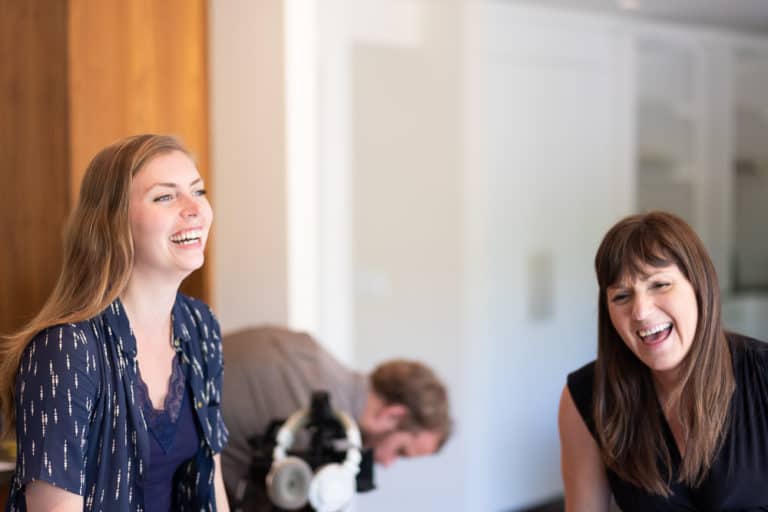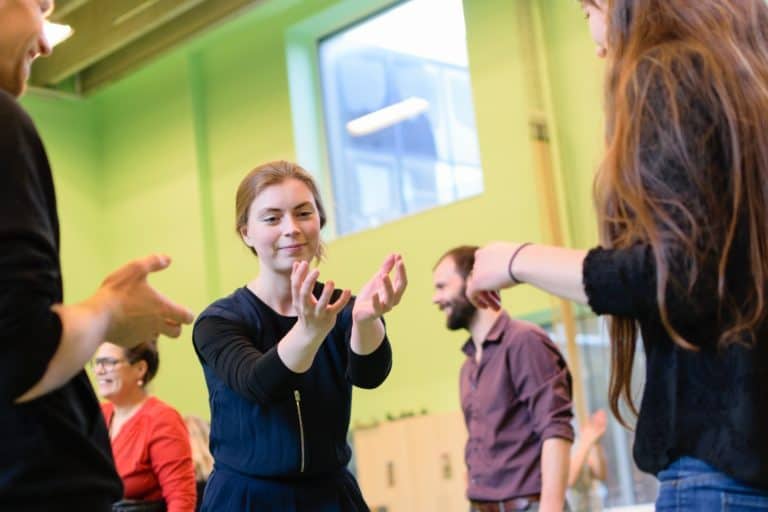Cataplexy and CounterPlay: Why I Want to Play More
Guest Post by Lisa
“So I read this thing about how needing to nap is a lot like needing to fart…”
When Julie Flygare shared this brilliant and hilarious comparison at the dinner table, an overwhelming urge hit me. It wasn’t a fart, nor was it sleep – it was cataplexy. My body slumped into my chair, my chin dropped to my chest and my eyelids fluttered. Blood rushing through my paralyzed body, I sat silently, fighting the limpness whilst indulging in joy. I could hear my friends (a group of recent graduates from the Rising Voices of Narcolepsy program) laughing along with me. I was happy.

In that instance, I gave in to the urge, but my instinct is usually to fight it (just like the farts and the napping) – and for good reason. Cataplexy is one of several symptoms of a serious chronic neurological condition called Narcolepsy type 1. Cataplexy can be embarrassing, inconvenient and frightening. My personal experience of cataplexy does not speak for everyone, nor does it summarize the condition, its effects and impact. Rather, what interests me here is within the realm where cataplexy and non-cataplexy co-exist – the realm of play.
My earliest memories of cataplexy are associated with playing as a child. I never seriously injured myself (or anyone else), and for a long time I considered it to simply be a bizarre, inconvenient ‘quirk’, much like my constant napping. Upon experiencing weakness in my knees, I learned how to ‘escort’ my body to the floor or to a seated position. Eventually, my friends learned how to help me, and cataplexy became a part of my personal way of playing.
Upon experiencing weakness in my knees, I learned how to ‘escort’ my body to the floor or to a seated position.
At some point during my teens, however, I started having fewer episodes of cataplexy. They became subtle and intimate, only triggered to their full-blown capacity by a few close friends. Some have interpreted this as my ‘conscious retreat from social situations where I might experience laughter’. There may well be some truth to this, but I can’t help but wonder if something else changed.
Parallel to the decline in dramatic episodes of cataplexy, I experienced a decline in ‘playful activities’. At some point, I stopped going over to a friend’s house ‘to play’. I stopped ‘playing pretend’, and I no longer played ‘it’ in the playground. Did I stop because I was afraid of cataplexy? It’s safe to say that I wasn’t the only one – everyone stopped playing.
I don’t recall any formal agreement to stop playing, nor can I pinpoint any final instances of play.
I don’t recall any formal agreement to stop playing, nor can I pinpoint any final instances of play. This shift from play to no-play was in fact a gradual transition that involved adopting new norms and modes of social interaction. There was of course still joy, and at times laughter – but nothing that resembled to the uninhibited and liberating play I had known before.
I have since sought to revive play in my life. Every time I feel the slackening of my jaw, I am reminded of the privilege of pure, uninhibited joy (even if I can’t express it). Close friends know that I still fall to the ground over silly SnapChat filters, unexpected sightings of wild animals and spontaneous giggle fits. I still get ‘weak in the knees’ during flirting and drop my head when I eat a KitKat. Netflix has a specific category of recommendations for people like me – it’s called ‘Reluctant Adults’.
Learn more about Lisa’s experience here:
However, the search for and facilitation of play is not always easy (or welcomed). I fall into the trap of ‘seriousness’ – as a student, as an employee and as a person walking down the street. I unconsciously embody rigidity, only to later compensate through dancing or drawing. It’s a bit like going for a run after days of physical inactivity, hoping that this somehow constitutes as a healthy ‘lifestyle’. I try to compensate for a lack of silliness in life.
These compensatory activities do bring joy, but they lack a certain spontaneity. I can’t reduce my trigger to a game, a song or a place, and I can’t ‘play on demand’. I can’t rationalize why certain people, activities or things make me happy, and any attempt to do so would probably defeat the purpose of play. And just as I am perfectly comfortable playing on my own, I also enjoy playing with other people.

For this reason I sought out the CounterPlay Festival, hosted in Aarhus, Denmark. Although my shyness kept my cataplexy at bay, the conditions for play throughout the three-day event were fantastic. Whilst speaking gibberish (yes, ‘made-up’ language) with a complete stranger, I realized that one of the defining qualities of such an arrangement was the legitimacy of play – simply being allowed to play. In this safe space, simple games and activities evolved into unique, playful experiences.
I realized that one of the defining qualities of such an arrangement was the legitimacy of play – simply being allowed to play.
The tricky thing about play is that it can be both completely invisible and deeply personal. However, I do not discount the importance of concepts such as ‘health’ or ‘love’ on this basis. In fact, I believe that more play in my life may even contribute to efforts in these two areas. As a former ‘play expert’ (i.e. child) I’m sure I can find more safe spaces to play, and I am grateful to anyone who will play with me.

To learn more about cataplexy, visit: https://project-sleep.com/facts-about-narcolepsy/
To learn more about CounterPlay, visit: http://www.counterplay.org/






2 Comments. Leave new
Thank you for writing about playfulness! My childhood with undiagnosed cataplexy wasn’t devoid of joy or playfulness but was characterized by a certain self-consciousness and distrust of my reactions to my own enthusiasm. In the past half year I made a resolution to “have more cataplexy,” meaning to embrace joy wholeheartedly, even in public. It’s been an interesting and worthwhile experience that, midway through was changed by a new medication that made me less likely to fall down or have obvious cataplexy. As is sadly true for most adults, my joy pathways are fainter than my to-do list, but it’s been a gift to experience more joy with and without cataplexy.
Nicely done. Well thought-out. Brought about many distinct ideas, and thoughts. But, I can’t remember the last time I played. I was most captured — and self-distracted — when I read, “…fall into the trap of ‘seriousness’ – as a student, as an employee and as a person walking down the street. I unconsciously embody rigidity”. I’ve so often wondered how this became my own “cope”/reaction. For me, I’d long-ago developed a sort of ‘concentration’ (more honestly, an overt distraction) to maintain a focus upon not letting go, or ‘getting caught off-guard’ – say, when overhearing an anecdote of someone on the bus, and it caught me so off-guard, I lapsed into Cataplexy-&-a-sleep. And entirely missed my stop. I’ve never figured-out how the ‘seriousness’ as a mind-set evolved (instead of something else).
Honestly, I just wanted to commend your writing. It struck a chord, and lasts. Thanks.